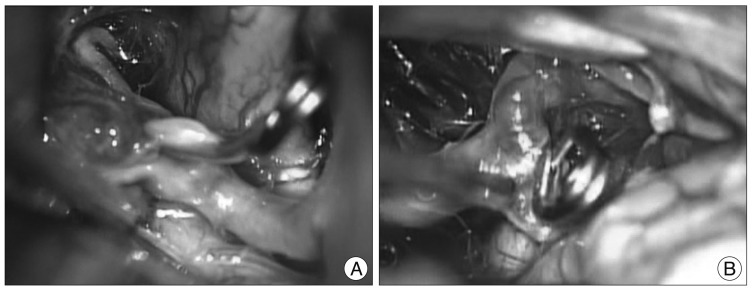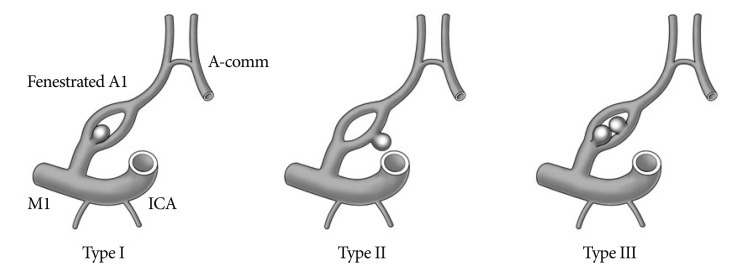J Korean Neurosurg Soc.
2013 May;53(5):293-296. 10.3340/jkns.2013.53.5.293.
Ruptured Saccular Aneurysm Arising from Fenestrated Proximal Anterior Cerebral Artery : Case Report and Literature Review
- Affiliations
-
- 1Department of Neurosurgery, Korea University College of Medicine, Seoul, Korea. hermes23@kumc.or.kr
- KMID: 1426197
- DOI: http://doi.org/10.3340/jkns.2013.53.5.293
Abstract
- The aneurysm arising from fenestrated proximal anterior cerebral artery (ACA) is considered to be unique. The authors report a case of a 59-year-old woman who presented with a subarachnoid hemorrhage (SAH) secondary to a ruptured aneurysm originating from the fenestrated A1 segment of right ACA. The patient had another unruptured aneurysm which was located at the right middle cerebral artery bifurcation. She was successfully treated with surgical clipping for both aneurysms. From the previously existing literatures, we found 18 more cases (1983-2011) of aneurysms associated with fenestrated A1 segment. All cases represented saccular type of aneurysms, and 79% of the patients had SAH. There were three subtypes of the fenestrated A1 aneurysms depending on the anatomical location, relative to the fenestrated segment. The most common type was the aneurysms located on the proximal end of fenestrated artery (82%). Azygos ACA and hypoplastic A1 were frequently accompanied by the aneurysm (33% and 31%, respectively), and multiple aneurysms were shown in three cases (16%). Considering that fenestrated A1 segment is likely to develop an aneurysm, which has high risk of rupture, early management may benefit patients with aneurysms accompanied by fenestrated proximal ACA.
MeSH Terms
Figure
Cited by 1 articles
-
Wire perforation of the missed tiny aneurysm originating from the fenestrated A1 segment during the endovascular approach
Seung Ho Shin, Won Ho Cho, Seung Heon Cha, Jun Kyeung Ko
J Cerebrovasc Endovasc Neurosurg. 2022;24(4):393-397. doi: 10.7461/jcen.2022.E2021.12.001.
Reference
-
1. Friedlander RM, Oglivy CS. Aneurysmal subarachnoid hemorrhage in a patient with bilateral A1 fenestrations associated with an azygos anterior cerebral artery. Case report and literature review. J Neurosurg. 1996; 84:681–684. PMID: 8613864.
Article2. Fujimoto Y, Yamanaka K, Nakajima Y, Yoshimura K, Yoshimine T. Ruptured aneurysm arising from the proximal end of an azygos anterior cerebral artery--case report. Neurol Med Chir (Tokyo). 2004; 44:242–244. PMID: 15200058.
Article3. Handa J, Nakasu Y, Matsuda M, Kyoshima K. Aneurysms of the proximal anterior cerebral artery. Surg Neurol. 1984; 22:486–490. PMID: 6495158.
Article4. Ihara S, Uemura K, Tsukada A, Yanaka K, Nose T. Aneurysm and fenestration of the azygos anterior cerebral artery--case report. Neurol Med Chir (Tokyo). 2003; 43:246–249. PMID: 12790284.
Article5. Inagawa T. Incidence and risk factors for multiple intracranial saccular aneurysms in patients with subarachnoid hemorrhage in Izumo City, Japan. Acta Neurochir (Wien). 2009; 151:1623–1630. PMID: 19669689.
Article6. Inagawa T, Takeda T, Taguchi H, Yamada T. A case of fenestrated anterior cerebral artery with an associated aneurysm. Hiroshima J Med Sci. 1983; 32:153–155. PMID: 6618896.7. Kachhara R, Nair S, Gupta AK. Fenestration of the proximal anterior cerebral artery (A1) with aneurysm manifesting as subarachnoid hemorrhage--case report. Neurol Med Chir (Tokyo). 1998; 38:409–412. PMID: 9745246.
Article8. Kobayashi S, Yuge T, Sugita Y, Kuratomi A, Katayama M, Iryo O, et al. Azygos anterior cerebral artery aneurysm associated with fenestration of the anterior cerebral artery. Kurume Med J. 1986; 33:149–153. PMID: 3599873.
Article9. Korosue K, Kuwamura K, Okuda Y, Tamaki N, Matsumoto S. Saccular aneurysm arising from a fenestrated anterior cerebral artery. Surg Neurol. 1983; 19:273–275. PMID: 6836482.
Article10. Mantatzis M, Kizilkilic O, Albayram S, Kocer N, Islak C. Endovascular treatment of aneurysms associated with fenestrated A1 segment of anterior cerebral artery : report of two cases. J Neuroimaging. 2011; 21:165–169. PMID: 19686315.
Article11. Minakawa T, Kawamata M, Hayano M, Kawakami K. Aneurysms associated with fenestrated anterior cerebral arteries. Report of four cases and review of the literature. Surg Neurol. 1985; 24:284–288. PMID: 4023910.
Article12. Mitsuhara T, Sakamoto S, Kiura Y, Kurisu K. Endovascular coil embolization for ruptured kissing aneurysms associated with A1 fenestration. Surg Neurol Int. 2011; 2:85. PMID: 21748037.
Article13. Ogasawara H, Inagawa T, Yamamoto M, Kamiya K. Aneurysm in a fenestrated anterior cerebral artery--case report. Neurol Med Chir (Tokyo). 1988; 28:575–578. PMID: 2460786.14. Ostergaard JR, Høg E. Incidence of multiple intracranial aneurysms. Influence of arterial hypertension and gender. J Neurosurg. 1985; 63:49–55. PMID: 4009274.15. Padget DH. The development of the cranial arteries in the human embryo. Contrib Embryol. 1948; 32:205–262.16. Park SB, Park JT, Kang SD. Ruptured aneurysm arising from a fenestrated A1 segment of the anterior cerebral artery. Korean J Cerebrovasc Dis. 2000; 2:84–86.17. San-Galli F, Leman C, Kien P, Khazaal J, Phillips SD, Guerin J. Cerebral arterial fenestrations associated with intracranial saccular aneurysms. Neurosurgery. 1992; 30:279–283. PMID: 1545903.
Article18. Taylor R, Connolly ES Jr, Duong H. Radiographic evidence and surgical confirmation of a saccular aneurysm on a hypoplastic duplicated A1 segment of the anterior cerebral artery : case report. Neurosurgery. 2000; 46:482–484. PMID: 10690739.
Article19. Wakabayashi T, Tamaki N, Yamashita H, Saya H, Suyama T, Matsumoto S. Angiographic classification of aneurysms of the horizontal segment of the anterior cerebral artery. Surg Neurol. 1985; 24:31–34. PMID: 4012555.
Article20. Wanibuchi M, Kurokawa Y, Ishiguro M, Fujishige M, Inaba K. Characteristics of aneurysms arising from the horizontal portion of the anterior cerebral artery. Surg Neurol. 2001; 55:148–154. discussion 154-155. PMID: 11311909.
Article21. Wiebers DO, Whisnant JP, O'Fallon WM. The natural history of unruptured intracranial aneurysms. N Engl J Med. 1981; 304:696–698. PMID: 7464862.
Article22. Yamada T, Inagawa T, Takeda T. Ruptured aneurysm at the anterior cerebral artery fenestration. Case report. J Neurosurg. 1982; 57:826–828. PMID: 7143067.
- Full Text Links
- Actions
-
Cited
- CITED
-
- Close
- Share
- Similar articles
-
- Ruptured Aneurysm Arising from a Fenestrated A1 Segment of the Anterior Cerebral Artery
- Ruptured proximal anterior cerebral artery (A1) aneurysm located at an anomalous branching of the fronto-orbital artery--a case report
- Aneurysms of the Proximal Anterior Cerebral Artery
- Fusiform Aneurysm of Proximal Anterior Cerebral Artery: Case Report
- Cerebral Aneurysm in the Long Fenestration at the Middle Portion of M1 Segment




